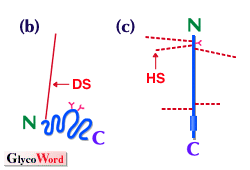| Proteoglycan-- |  |
| Masaki Yanagishita (Tokyo Medical and Dental University, School of Dentistry) | |
|
 |
Proteoglycans are a class of glycosylated proteins which have covalently linked sulfated glycosaminoglycans, (i.e., chondroitin sulfate, dermatan sulfate, heparan sulfate, heparin, keratan sulfate). The protein component of proteoglycans is a core protein which directs the biosynthesis of proteoglycans to different molecular constructions and functions. So far, more than 20 genetically different species of core proteins have been identified. Glycosaminoglycans are sulfated polysaccharides made of repeating disaccharides (typically a repeat of 40-100 times), which consist of uronic acid (or galactose) and hexosamines. They endow proteoglycans with unique functions. The components of disaccharides are (glucuronic acid/iduronic acid -N-acetylgalactosamine) in chondroitin sulfate and dermatan sulfate,(glucuronic acid/iduronic acid -N-acetylglucosamine) in heparan sulfate and heparin, and (galactose -N-acetylglucosamine) in keratan sulfate. Sulfation of glycosaminoglycans in chondroitin sulfate chains is usually regular, one sulfate per disaccharide throughout the chain, while in heparan sulfate chains, sulfation is somewhat irregular, resulting in intensely sulfated and sparsely sulfated regions on a single glycosaminoglycan chain. In addition to glycosaminoglycans, proteoglycans normally have other carbohydrate units including O-linked and N-linked oligosaccharides, as found in other glycosylated proteins.
Biological functions of proteoglycans derive primarily from those of the glycosaminoglycan and protein component of the molecule. Glycosaminoglycans assume extended structures in aqueous solutions because of their strong hydrophilic nature based on their extensive sulfation, which is further exaggerated when they are covalently linked to core proteins (a typical example is aggrecan, see below). They hold a large number of water molecules in their molecular domain and occupy enormous hydrodynamic space in solution. Another remarkable property of the glycosaminoglycans, which is particularly significant in heparan sulfate and heparin, is their capability to specifically interact with a number of important growth factors and functional proteins. Such interactions are often crucial to the biological functions of these proteins. This subject has been drawing much attention and will be further elaborated in other articles in this series. Properties of core proteins are also exerted through interactions with other molecules, especially when proteoglycans are involved in the formation of extracellular matrix. | |
|
 |
 |
Models of typical proteoglycans; (a) aggrecan, (b) decorin and (c) syndecan 1. NH2 and COOH termini of core proteins are indicated by N and C, respectively. Glycosaminoglycans are depicted by red lines (i.e., solid line, chondroitin sulfate / dermatan sulfate CS / DS; broken line, heparan sulfate HS; wavy line, keratan sulfate KS). Models show approximate, comparable sizes of molecules when they are stretched. A block in the syndecan 1 core protein illustrates the transmembrane hydrophobic domain. |
|
|
| The most studied, prototypical proteoglycan is the aggrecan (Figure, panel a), which constitutes the major component in articular cartilage and accounts for by far the largest mass among proteoglycans in animal bodies. Aggrecan has a hyaluronan-binding domain near its amino terminal and forms an enormous supramolecular structure together with hyaluronan and another protein (called the "link protein") in articular cartilage tissues. It provides articular cartilage with its major function of resisting compressional forces. This was the first proteoglycan molecule found in the late 19th century, was the main subject of proteoglycan research until the 1970's, and has provided fundamental knowledge about the molecular structures of proteoglycans.
The biosynthesis of proteoglycans, in addition to the ordinary biosynthetic processes of O- and N-linked oligosaccharide components as in other glycoproteins, further requires biosynthesis of glycosaminoglycans in the Golgi apparatus, which can be considered to be a most complex biosynthetic process for complex carbohydrates. It requires a number of glycosyltransferases and sulfotransferases and involves multiple subregions of the Golgi apparatus, which poses a great challenge for researchers in elucidating the organization and regulatory mechanisms involved in proteoglycan biosynthesis.
| |
|
|
| References | (1) | Iozzo, R. V., and Murdoch, A. D.: Proteoglycans of the extracellular environment: clues from the gene and protein side offer novel perspectives in molecular diversity and function. FASEB J. 10:598-614 (1996) |
| (2) | Yanagishita, M., and Hascall V. C.: Cell-Surface Heparan Sulfate Proteoglycans. J. Biol. Chem. 267:9451-9454 (1992) |
| | |
| |
| Dec.15, 1997 |
|
| |
|
|
|
|



